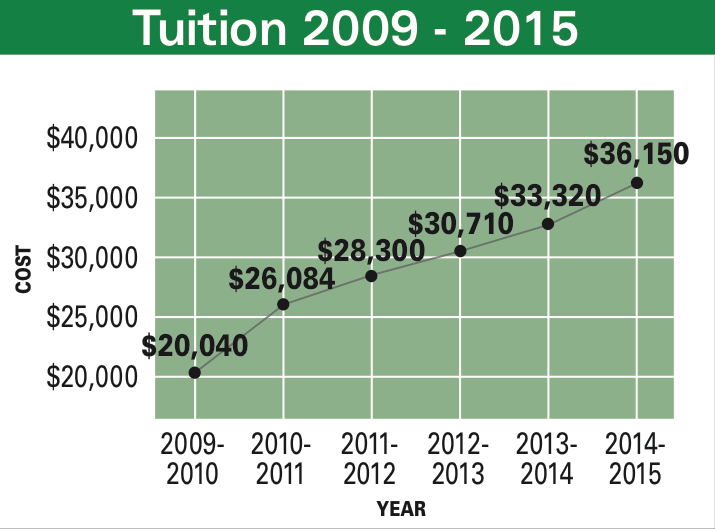Lower tuition increase means fewer new dollars for university next year
Tuition will increase by six percent for the 2015-2016 school year at St. Edward’s University, President George E. Martin announced at his state of the campus update on Sept. 24.
Setting tuition
This increase, which was approved by the Board of Trustees, is 2.5 percent lower than the previous tuition increase.
Since St. Edward’s is a not-for-profit, the board is charged with the governance of the university. The board’s fiduciary committee manages financial affairs, such as setting tuition and approving the budget.
Vice President of Financial Affairs Kim Kvaal serves as the staff resource to the committee.
Kvaal’s office is primarily responsible for the university’s business operations — accounting, financial reporting, human resources, facilities, the university police and auxiliary services.
As a non-voting member, Kvaal provides information to the committee, who in turn decides on a tuition increase and presents it to the board for approval.
For example, Kvaal advises the committee on market forces and the university’s needs — the primary factors in tuition pricing.
“How much revenue do we need in order to deliver the programs and services that make a St. Edward’s education,” Kvaal said.
Investing for our future
Students like Katy Dirienzo, a senior psychology major, are saddened by the yearly tuition increases.
Dirienzo says she is taking 18 hours this semester as well as taking two CLEP tests in order to graduate early and avoid any more student debt.
“Don’t get me wrong,” Dirienzo said. “I think that the education we receive is definitely priceless, and I love St. Edward’s more than anything, but when it comes to reality, I feel like the only way to avoid more debt is to pile up and finish early.”
What’s interesting about this next year’s tuition is the reduction in percent increase.
Kvaal thinks that the university always tries to increase tuition by the lowest amount possible in order to deliver its mission and achieve its strategic goals of being a 21st century university.
“I would say that the university recognized continuing to raise tuition at 8.5 percent was not viable any longer because of market force, because of our students’ ability to pay, and so set a tuition rate increase that was lesser than in previous years,” Kvaal said.
Some students, like junior theater major Trey Stoker, are optimistic about the lower increase rate.
“My view is simply that tuition rises every year, and compared to previous years this percentile increase is actually down, and that a large amount of colleges do this and it shouldn’t be a cause for outrage,” Stoker said.
This lower increase rate creates an interesting situation for the university next year, as there will be less new dollars coming in.
For this reason, the administration is undertaking a process entitled “investing for our future,” in which they look at opportunities for reallocation of existing dollars, so the university can continue to invest in strategies that will fulfill its goals with fewer resources.
“We are going to have less new dollars, so what we’re looking at this year is what are the things that we’re currently doing that maybe there’s a new way to do it that’s more efficient,” Kvaal said. “Maybe we are doing something that, because of technology, we can do more efficiently; or maybe we are doing something that a long time ago made sense, but maybe it’s not as important as it used to be, and maybe this new thing is more important than this existing thing that we’ve always done and so we’ll trade off.”
Rising cost of education
Tuition increases almost feel inevitable, as evidenced from the last decade.
According to Kvaal, this is because the cost of delivering an education continues to increase.
The university wants to pay competitive salaries to its faculty and staff. The cost of heating and cooling buildings increases as energy prices increase. The cost of insurance increases.
“On the cost side, you have every cost going up because of the economy, and so they’re driving the price up as well,” Kvaal said.
The driving force
Prioritizing the budget is driven primarily by the 2015 strategic plan.
“All of the decision making is help up against the strategic plan, and then the mission statement is the underpinning of the strategic plan.” Kvaal said.
Although much has changed since the strategic plan was unveiled in fall 2015, the goals were written broadly enough so that there’s room for plan to grow and change as time passes.
“Benchmarks of where we want to be haven’t changed,” Kvaal said.
Who are those competitors?
Part of tuition setting is determined by market forces, like demand and the competitor group the university operates in.
“We look at how our tuition compares to our competitors in price and then in value as well,” Kvaal said.
St. Edward’s determines its competitors based on cross-applications, according to Kvaal.
The university has data of what other schools to which prospective students have applied.
Austin College, Trinity University, Baylor University, Texas Christian University and Southern Methodist University were among others on the list of competitors.
Tulane University and Loyola University were two out-of-state schools where there were also a lot of cross application, according to Kvaal.
When asked about the University of Texas at Austin, Kvaal said that the university does not consider it a competitor.
“We’re a very different school than UT, so we don’t compare ourselves to UT,” Kvaal said.
Financial aid
St. Edward’s has also increased its budget for financial aid for the coming year.
Financial aid is funded from a number of sources: state funds, federal funds, the university’s endowment, donations specifically for scholarship and unfunded aid.
Tuition dollars, which go toward unfunded aid, are by far the largest source of funding for financial aid, according the Kvaal.
“It’s sometimes called the discount,’ Kvaal said of the unfunded aid.
Raising the endowment
In 2013, St. Edward’s endowment was $82,658,955, according to U.S. News and World Report.
The endowment consists of money that is donated specifically to the fund as well as money that the university determines it wants to set aside in the fund. This money is invested long term, and the earnings from the investments are then used towards scholarship, faculty endowed chairs and other miscellaneous purposes.
Right now, St. Edward’s is considered a tuition-dependent university. However, the Office of Development is fundraising to raise contributions for the university, with their current campaign focusing on the endowment.
If the endowment is raised significantly, then there is more money available to support scholarships, likely minimizing the yearly tuition increases.
“The larger your endowment, the less pressure their is on tuition,” Kvaal said.







